Key takeaways:
- Reparations politics is deeply emotional, rooted in historical injustices, and requires engagement with community narratives to foster healing and restitution.
- The impact of historical injustices persists in contemporary communities, affecting resources, health care, and housing, highlighting the need for active discussions on reparative justice.
- Local community actions, such as organizing clean-ups and mutual aid groups, demonstrate a collective effort to address systemic issues and empower residents.
- Strong community bonds can be built through shared experiences and open dialogues, emphasizing the importance of connection in overcoming local challenges.

Understanding reparations politics
Reparations politics is a complex and deeply emotional terrain, often rooted in historical injustices. When I ponder this issue, I feel a profound connection to those who have suffered systemic oppression. For instance, I once attended a community meeting where an elder shared their family’s history of displacement—a reminder that these stories are not just statistics but lived experiences.
As I navigate conversations around reparations, I can’t help but ask: what does true justice look like for communities impacted by generational trauma? It’s a question that weighs heavily on my heart. Engaging in reparations discourse pushes us to consider both the acknowledgment of past wrongs and the tangible steps towards healing and restitution for those affected.
Understanding reparations also requires a grasp of varying perspectives within our communities. I recall a lively debate among friends where differing opinions sparked insights I hadn’t considered before. That evening, we explored themes of accountability, restitution, and what reparative justice truly means—demonstrating that while the topic can be divisive, it ultimately compels us to engage deeply with our shared history and future aspirations.

Historical context of reparations
Reparations have a long history rooted in the aftermath of slavery, colonialism, and systemic racism. I remember studying primary sources in college, where I stumbled upon letters from freed Black slaves advocating for land and resources to build their lives anew. It struck me how those early calls for reparative justice were about more than just financial compensation; they were about the dignity and recognition of their humanity.
In my own neighborhood, the echoes of historical injustices continue to resonate. For instance, when planning community events, I often feel the weight of decisions made decades ago that have impacted our local resources and infrastructure. It leads me to wonder: how would our community look if those injustices had been addressed at their inception? The contrast reminds us that reparations aren’t merely a financial matter—they encapsulate a broader vision of healing, restitution, and recognition.
The discussion of reparations also invites us to acknowledge various attempts throughout history, both successful and not. Reflecting on the post-World War II reparations for Japanese Americans creates a compelling parallel for current conversations. It raises questions in my mind about the efficacy and sincerity of such efforts: have we truly learned from past injustices, or are we still repeating history?
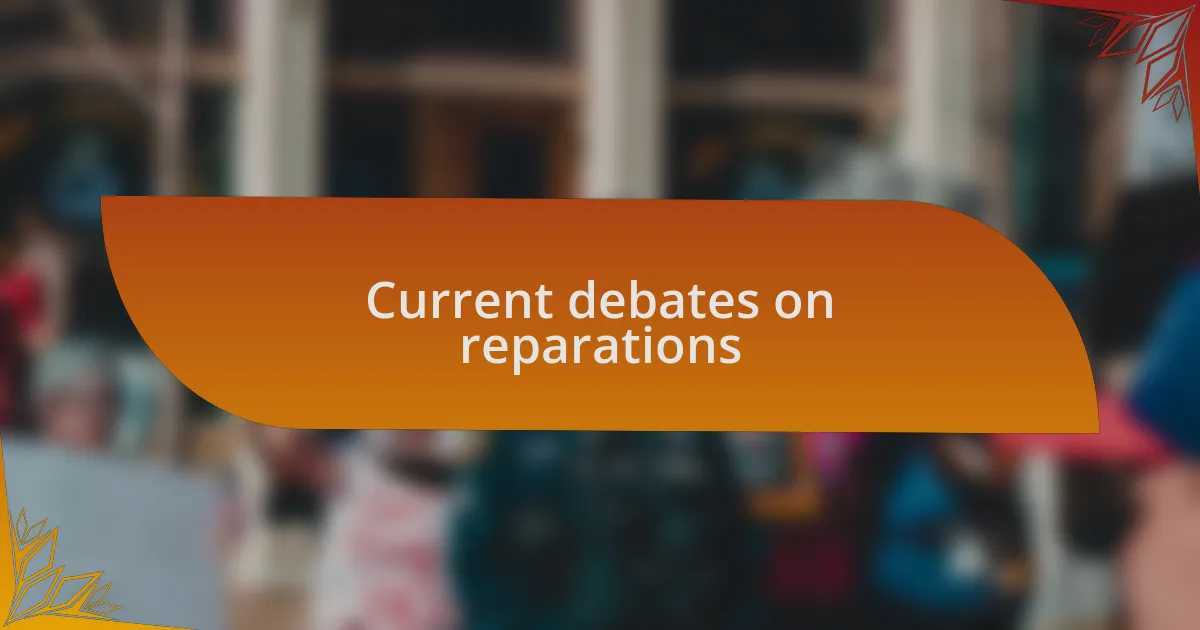
Current debates on reparations
Current debates on reparations vary widely, reflecting the complexities of addressing historical wrongs. I recently attended a community forum where activists shared passionate views about what reparations should entail—whether it’s financial compensation, education funding, or community development initiatives. This made me realize how multifaceted the conversation is; the needs of my neighborhood might differ drastically from those in another region.
One argument that stands out in discussions is whether reparations should directly benefit descendants of slaves or focus on broader societal reforms that uplift marginalized communities. Personally, hearing stories from older residents who faced discrimination in housing and employment deeply moved me. It raised a crucial question: should the reparations conversation also confront ongoing inequities that make these stories still relevant today?
The challenge lies not just in determining who should receive reparations but also in figuring out the best mechanisms to implement them. I often ponder whether tangible actions, like land grants or scholarships, could evoke a genuine sense of justice. As I engage with neighbors, I hear voices yearning for change—what will it take for those voices to ignite a movement that truly reflects our collective history and aspirations?
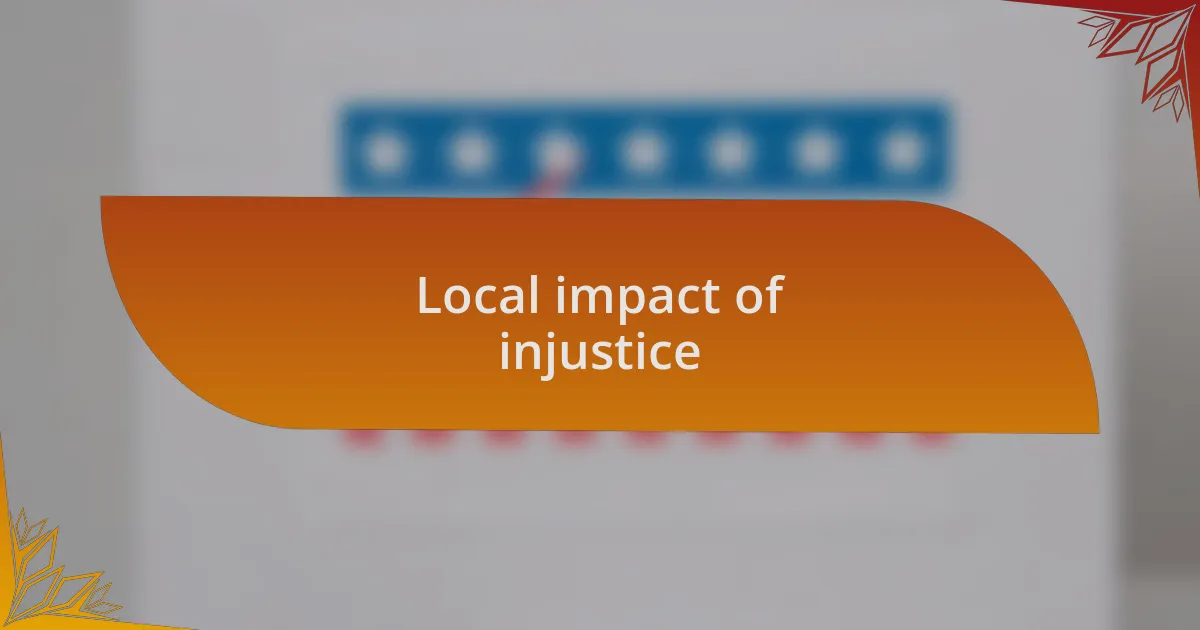
Local impact of injustice
The local impact of injustice in my neighborhood is palpable. Just last week, I spoke with a single mother who recounted her struggles to secure stable housing. Her experiences with landlords who exploit vulnerable tenants made me reflect on how systemic failures perpetuate cycles of poverty, harming families and limiting their potential. How often do we overlook these everyday injustices?
I can’t help but notice the stark contrast between parts of my community. In one area, new businesses flourish, while just a few blocks away, long-standing residents are trapped in a deteriorating environment. It’s disheartening to realize that such disparities are often tied to historical injustices that linger on today. Conversations around reparations must also address how these inequities manifest in our neighborhoods—what would it take to bridge that gap?
One poignant moment for me was when local youth organized a rally to demand better educational resources. Their passion reminded me that the impact of injustice extends beyond immediate needs. It creates a sense of hopelessness that can stifle ambition. How do we foster hope where injustice has laid its claim? The answer lies in acknowledging these realities and advocating for transformative change that empowers those affected.
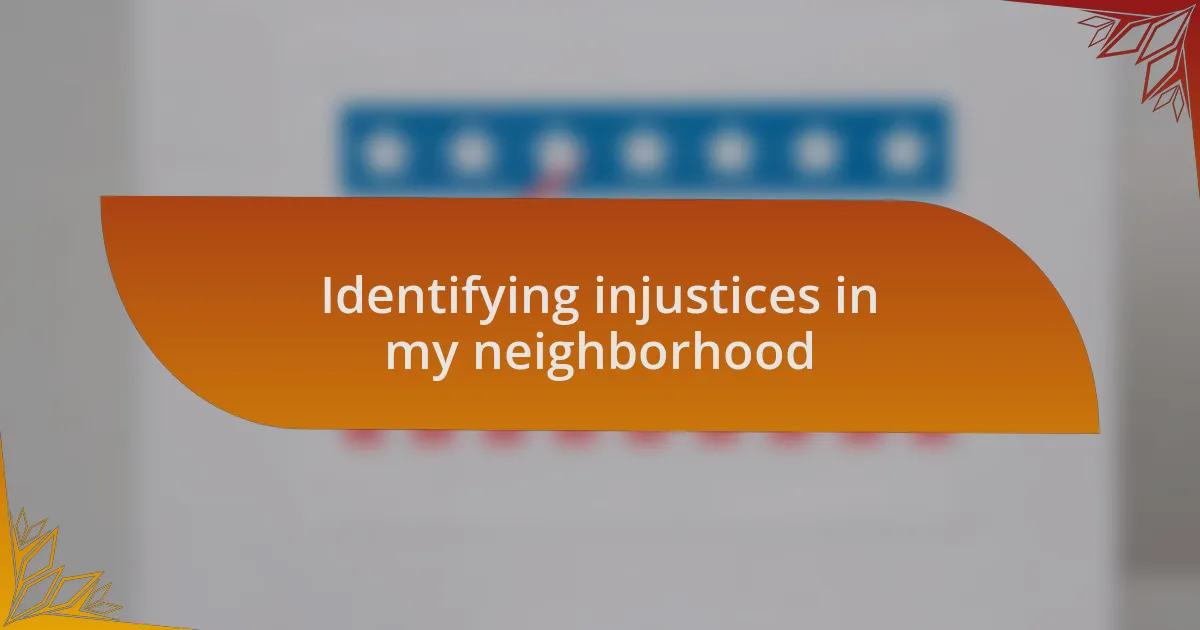
Identifying injustices in my neighborhood
Identifying injustices in my neighborhood feels like peeling back layers of a complex story. Just the other day, I walked through a nearby park and noticed how its degraded facilities reflect the neglect experienced by certain sections of our community. The absence of safe play areas for children is not just an oversight; it symbolizes a lack of investment in their futures. How much longer must they play in places that don’t support their well-being?
I often hear from friends who are frustrated by the health disparities in our area. One conversation that struck me was with a local elder who shared his battle with chronic illness and how the nearby clinic often lacks essential supplies. It’s heartbreaking to think that access to quality healthcare still depends on where you live. Shouldn’t everyone have equal access to health services that affect their quality of life?
Reflecting on my neighborhood’s past, I’ve come to recognize how historical decisions continue to affect our current reality. Just last week, I met with a group of residents working to document the changes in our community over the last few decades. Their stories revealed how redlining and discriminatory practices still echo in today’s housing market. How can we move forward without confronting these past wrongs and acknowledging their lingering impact?
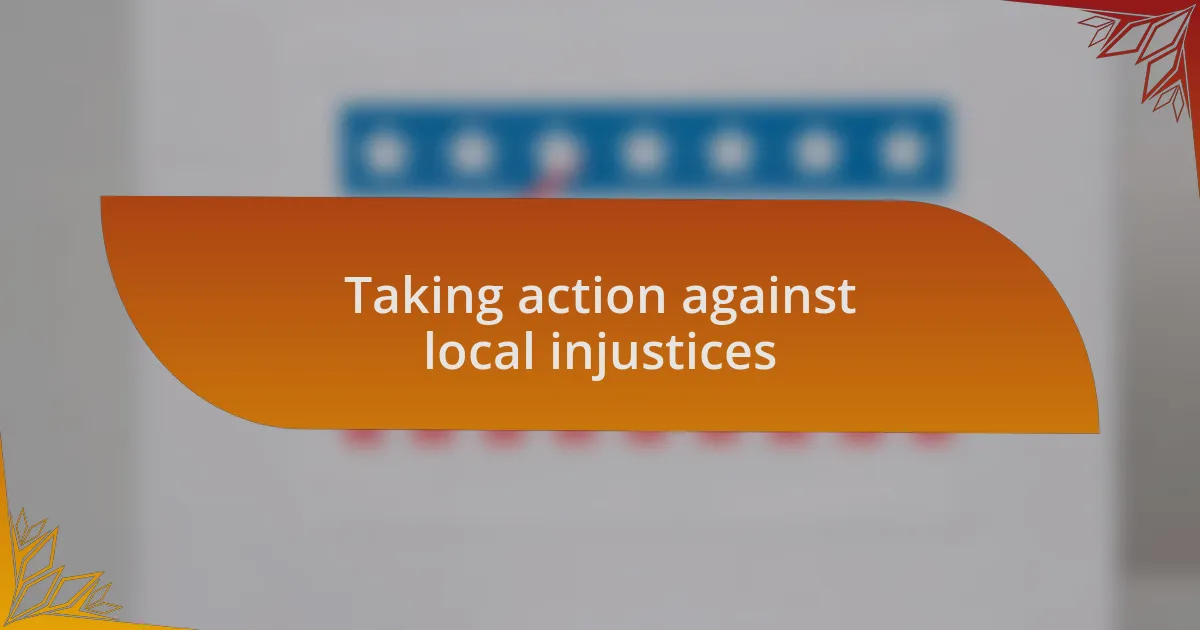
Taking action against local injustices
Taking action against local injustices requires a collective effort that resonates deeply within our hearts. I remember attending a community meeting where we discussed organizing a weekly clean-up in neglected areas. The energy was electric as neighbors shared their hopes for a cleaner environment, but more importantly, we were united in restoring dignity to our shared spaces. Why should our community be a reflection of neglect instead of pride?
One day, I decided to channel my frustrations into action by volunteering at a local food pantry. It was eye-opening to see firsthand the struggles families face daily due to food deserts in our area. Each face that came through the door told a story, and I found myself wondering—what can we do to ensure everyone has access to healthy meals? Every meal distributed felt like a small victory, reinforcing my belief that we can uplift one another if we take the initiative.
Moreover, I recently joined a small advocacy group aiming to engage local officials about improving health services. During a rally, I saw how passionate voices could ignite change. As I stood by other activists, I couldn’t help but feel a sense of empowerment wash over me. If we don’t speak up about these disparities, who will? Taking action is not just about addressing the issues at hand; it’s about building a stronger, more just community for everyone.
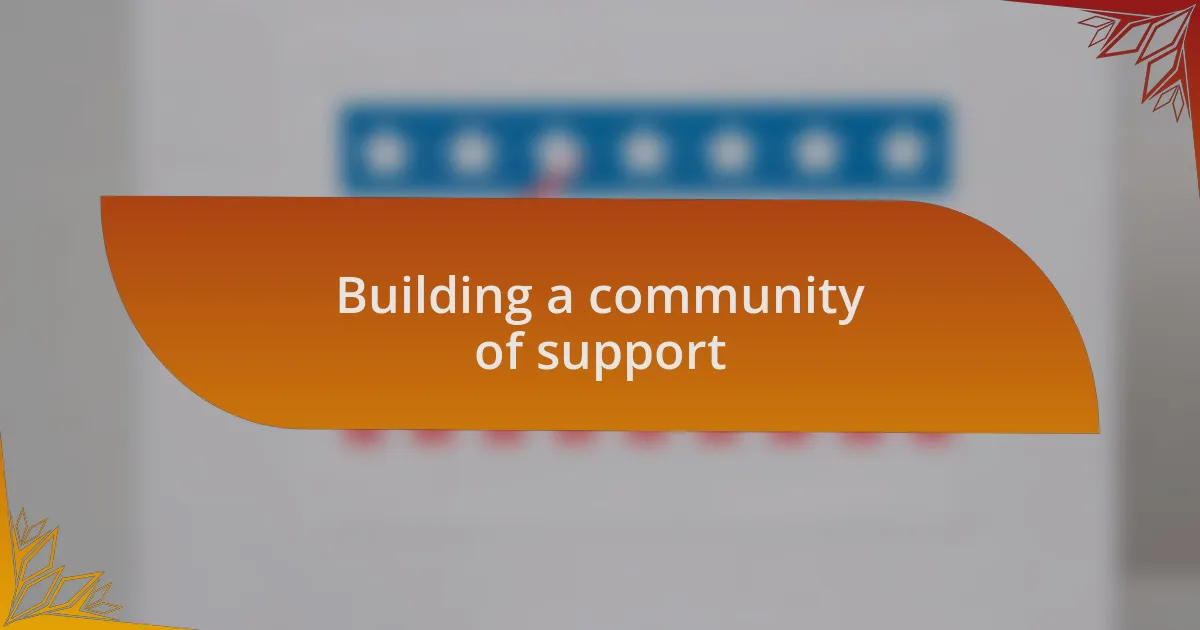
Building a community of support
In the heart of our neighborhood, I realized the power of connection when we created a mutual aid group. At our first gathering, I felt a wave of warmth as we exchanged ideas and resources, transforming our individual struggles into a shared mission. Have you ever felt that sense of community, where everyone pitches in to lift one another up? It’s an incredible feeling—knowing we’re not alone in facing challenges.
One evening, while organizing a block party, I witnessed firsthand how a simple gathering could strengthen bonds. Neighbors who previously barely acknowledged each other suddenly found common ground over food, music, and laughter. I thought, how often do we let our busy lives get in the way of connection? This experience solidified my belief that a supportive community starts with small, intentional actions that foster relationships.
Just last month, I helped lead a workshop on conflict resolution techniques, which was a game-changer for our group. I encountered moments where participants shared their frustrations, revealing a wealth of untold stories. It struck me—how often do we avoid these discussions out of fear? By creating a safe space, we not only built trust but also empowered each other to address deeper issues, proving that our differences can be our greatest strength when we come together.